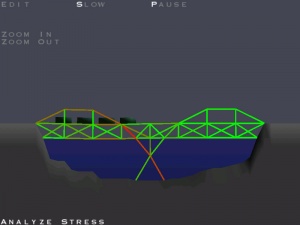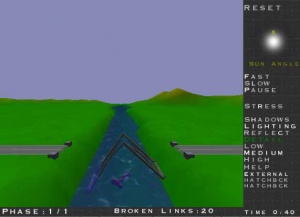CS382:Structural-outline
Contents
Abstract
- This unit will most likely span two weeks, and will explore the significance a basic concepts surrounding structural modeling. We will teach the students how the physical properties of structures in the real world can be represented inside computational systems. Bridges are a good example of structures that must be evaluated extensively before they are physically built. Additionally, there are a few programs (Engineering oriented games) that provide interfaces for both building the virtual bridges and testing their weight capacity under variable loads.
- As a side-note, we are interested in possibly expanding the scope of this unit into a basic overview of rigid body dynamics and touching briefly on other examples that model dynamic objects in a static enviroment. Cool, but should this be for its own unit?
The Scaffold Approach
- The scaffold pedagogy emphasizes the importance of introducing new ideas and concepts by explaining how those new concepts fit into the context of the material previously covered. Information is contextualized as pedagogical dependencies.
- Our bridge unit is scaffolded in the sense that as students learn about the structural intricacies of bridge building, they will be able to construct more effective models. The high-level view of bridge types will allow the students to implement these qualities into the bridges they build in the simulator. Once the simulation is complete, the students will build a physical model under the expectations that the K'nex will behave as expected given the test results show by the computer program. Each lecture/lab activity depends on previous class work.
General Education Requirements
Abstract Reasoning
They focus substantially on properties of classes of abstract models and operations that apply to them.
- Sort of. This lab is more concrete. This unit will go early in the semester so it will apply some of the more abstract ideas presented earlier.
They provide experience in generalizing from specific instances to appropriate classes of abstract models.
- Yes, because we're showing how structures and bridges, specifically apply to the abstract model parameters described in the What is a static model and what is a dynamic model units.
They provide experience in solving concrete problems by a process of abstraction and manipulation at the abstract level.
- Eh, again, this unit isn't geared towards this as far as I can see.
Quantitative Reasoning
Using and interpreting formulas, graphs and tables.
- not really. or maybe... If we use the pasco solution, the beam strength will be documented, and the students can perform basic calculations to figure out whether beams will break under a certain load.
Representing mathematical ideas symbolically, graphically, numerically and verbally.
- The models provide a framework for visualizing physical (mathematical) constraints.
Using mathematical and statistical ideas to solve problems in a variety of contexts.
- This is one context where we're using mathematical and statistical ideas.
Using simple models such as linear dependence, exponential growth or decay, or normal distribution.
- Not really.
Understanding basic statistical ideas such as averages, variability and probability.
- Yes, because the traversal (where we test the bridge by simulating a car driving over it) is a deterministic process. Maybe we could introduce the difference between probabilistic and deterministic.
Making estimates and checking the reasonableness of answers.
- Yes, because students will try to build different types of bridges and determine the 'reasonableness' of their solutions by the simulated test outcome.
Recognizing the limitations of mathematical and statistical methods.
- yes, because the physical model will not account for all variables, such as wind.
Inquiry Based Learning
Develops students' understanding of the natural world.
- Modeling physical structures is important because the natural world is comprised of physical structures.
Strengthens students' knowledge of the scientific way of knowing — the use of systematic observation and experimentation to develop theories and test hypotheses.
- The students will determine the most appropriate method to build a simulated bridge through both lecture content and trial and error. They will test their models by building physical models of their virtual structures. Cool.
Emphasizes and provides first-hand experience with both theoretical analysis and the collection of empirical data.
- The students collect the empirical data by synthesizing lecture content and trial and error. They (potentially in groups) will each devise different models to solve the same problem.
Background reading
http://pghbridges.com/basics.htm
- This is a page containing a number of basic types of bridges, and some information about their origin, and/or how they function.
http://www.in.gov/indot/files/bridge_chapter_01.pdf
- "Bridge building for dummies." Provides an explanation of the duties of Bridge Technicians and defines a number of terms associated with bridge constructions, as well as explaining some of the more common failure points and why they're failure points.
- Now, do we want the students reading all of this, or is this material for the teacher/TAs to review so they can have a solid basis of information from which to teach the material?
http://en.wikipedia.org/wiki/Rigid_body_dynamics
- An overview of applications/techniques associated with developing models of physical objects as they interact with both the static environment and each other.
- Is this conditional on the extension of this unit?
http://www.lessonplanspage.com/ScienceSSOKNEXBridges-Architecture510.htm
- The lesson plan that involves K'nex, if we want to go ahead with that.
- Make an assumption of lab group size and materials needed per group, then draw up an estimate of how much this would cost for a class of 80 (worst case scenario)
http://www.apeg.bc.ca/services/branches/documents/pr/Bridge_Engineering_Principles.pdf
- Goes over some of the basic principles of bridge-building.
http://www.yale.edu/ynhti/curriculum/units/2001/5/01.05.04.x.html
- Lesson plan for younger students. Could be useful for building a lecture for an audience with little to no background.
Lecture notes
Lecture 1:
- Review key concepts from the units on static and dynamic models, remind people of the difference, and how the two types of models work in conjunction.
- Explain the various types of bridges introduced in Bridge Basics
- Explain why how modeling structures such as bridges is different than earlier examples of fire, etc, and how certain key aspects of the procedure and underlying theory are the same
- Prepare the class to do the lab. If they're going to use bridge builder, this section could be a demonstration of the software and features.
Lecture 2:
- Begin to explain the more complex aspects and issues surrounding rigid body dynamics.
- RBD involves solid objects and their interaction with other objects in a simulated world.
Lecture 3:
- Review Lab 1
- Since we are aiming to fill two weeks with this unit, this lecture could go two ways here.
- On one hand, we could continue working with the bridge framework, potentially expanding our model into 3 dimensions
- Alternativily, we could move away from bridges entirely and focus on a more complex example, like a high-level tour of a typical physics engine. The technical content might be tough to navigate, and might raise questions that are difficult to answer without causing further confusion.
- Prepare students to complete lab 2.
- Sounds like we should make a decision about where this unit wants to go
Lecture 4:
- Finish the sub-unit on physics engines, and relate it back to the bridge builder program and the notion of rigid body dynamics.
- Relate the Bridge/structural modeling unit to the previous units, try to reassure everyone (??? Reassure them of what!) and allieviate any confusions or further questions that students might have.
Classroom response questions
- After an explanation of some of the concepts in the earlier lectures, have an image comparison of 2 bridges made in Bridgebuilder, ask students which of the two would be stronger.
- Is this model static or dynamic?
- Which is stronger; an arc or a triangle? I wonder, would they have learned this through readings, or through empirical testing? Do the bridge programs allow arcs or just straight segments?
Otherwise, good stuff.
Lab activity
The Lab activity will consist of two sessions.
- The first session will involve constructing simulated bridges and testing those bridges using one of the fine programs listed below.
- The second session will involve physically modeling (replicating the simulated designs created the week before. This might work best as a group project.
- Good plan
Simulations
- Simple, effective, fun bridge building/simulation game. Illustrates structural stress with colors. Might be too simplistic, because it only simulates in 2 Dimensions. Additionally, the software appears to be non-free, and although there is a free 'demo' download for mac/windows. The demo appears fully functional, however the Bridge Builder website advertises a 3-D version with a paid licence. How much is that?
- The program is organized into 'Levels' ranging in difficulty from 'Level 1' and 'Level 15.' This could translate to a convient lab format, where we can assign a certain number of levels. There are some good videos on youTube that demonstrate the increased challenge of each subsequent level.
- Another bridge-building computer game. This game offers 3-D construction. It also costs $19.99. But, a demo is available for mac
- This program is really neat, the animations are fairly detailed, and there are keyboard controls to move the camera around the simulated world. The game uses 'Levels' of increasing complexity, and even the demo has 5 levels. Completing all five demo levels could be enough for a single lab. Additionally, if the class is building virtual bridges in three dimensions, the lab could involve first building the bridge designs in Bridge Construction Set and then next week building a subset of those bridges using K'nex.
- An open source physics engine used in many applications. This came from a search on physics engines, which seem to be heavily related to modeling bridges and other structures. There might be some pedagogically useful aspects of this software, however delving to deep into the intracacies of linear algebra and vector multiplication might seriously confuse and frustrate many of the non-math people. Note that it may be possible to implement some pre-built objects / functions to make the software more accessible to newbies.
Physical Models
Constructing physical bridge models with K'nex How many of these would be needed in the worst case?
- The tactile, hands-on aspect of building real models would be a good way to make the labs fun, while also teaching the students to associate the 3-Dimensional (or 2 Dimensional, in the case of 'Bridge Builder') image of the bridge inside the computer to the physical, very real concept of a model. Building some of the models build inside the program would informally demonstrate the concept of verification of the computational model built in the previous week's lab period. K'nex are an effective physical analogue to the computer simulation methods described above. The strength of these K'nex constructions could be tested simply by hanging weights off of them at various points.
Scheduling
This unit would be well suited for early in the semester. The basic concepts of bridge design are fairly straightforward, and labs are game-oriented.
- This is good material, and the bridge building effectively shows how the mining of data can be used to make models which then help the creation of new physical manifestations-- but I think this unit needs to narrow down on exactly what it wants to teach. To do RBD or not? To do physics engines or not? Will this lab have "hard modes" for extra credit? A resolution of the unit's intent will make the lecture outline a lot more coherent. Ditto
- Also, the teacher/TAs will have to make sure they got this material under their belt when this lab rolls around, or, as you mentioned above, there will have to be some "reassuring," and we don't want the students to lose faith!
Thoughts
- Pasco less expensive than K'NEX, Charlie has these available in a magazine
- Can put in strain and stress gauges pretty easily - so look at this and see which you think might be better choice

